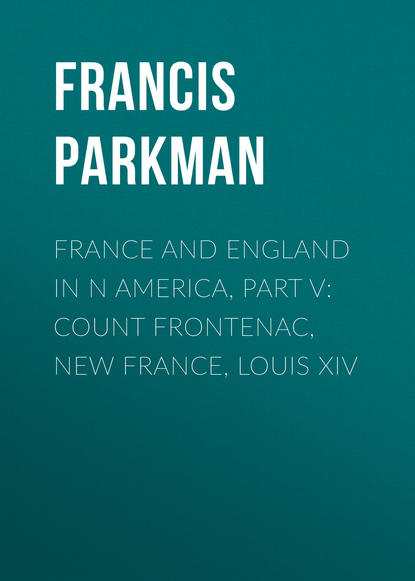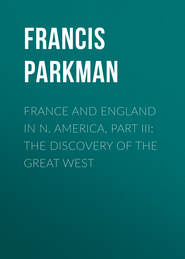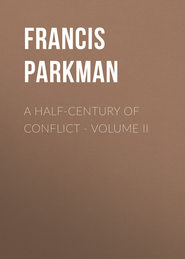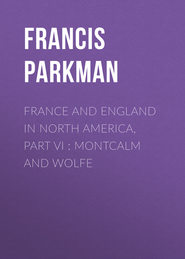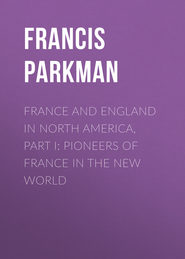По всем вопросам обращайтесь на: info@litportal.ru
(©) 2003-2024.
✖
France and England in N America, Part V: Count Frontenac, New France, Louis XIV
Настройки чтения
Размер шрифта
Высота строк
Поля
The ravages committed by the Abenakis in the preceding year among the scattered farms of Maine and New Hampshire are said by Frontenac to have been "impossible to describe." Another French writer says that they burned more than 200 houses.
384
Villebon, Journal de ce qui s'est passé à l'Acadie, 1691, 1692; Mather, Magnalia, II. 613; Hutchinson, Hist. Mass., II. 67; Williamson, History of Maine, I. 631; Bourne, History of Wells, 213; Niles, Indian and French Wars, 229. Williamson, like Sylvanus Davis, calls Portneuf Burneffe or Burniffe. He, and other English writers, call La Brognerie Labocree. The French could not recover his body, on which, according to Niles and others, was found a pouch "stuffed full of relics, pardons, and indulgences." The prisoner Diamond told the captors that there were thirty men in the sloops. They believed him, and were cautious accordingly. There were, in fact, but fourteen. Most of the fighting was on the tenth. On the evening of that day, Convers received a reinforcement of six men. They were a scouting party, whom he had sent a few days before in the direction of Salmon River. Returning, they were attacked, when near the garrison house, by a party of Portneuf's Indians. The sergeant in command instantly shouted, "Captain Convers, send your men round the hill, and we shall catch these dogs." Thinking that Convers had made a sortie, the Indians ran off, and the scouts joined the garrison without loss.
385
"Le 18
(Août) un sauvage anglois fut pris au bas de la rivière de St. Jean. Je le donnai à nos sauvages pour estre brulé, ce qu'ils firent le lendemain. On ne peut rien adjouter aux tourmens qu'ils luy firent souffrir." Villebon, Journal, 1691, 1692.
386
Champigny au Ministre, 4 Nov., 1693.
387
Frontenac au Ministre, 25 Oct., 1693.
388
Lagny, Mémoire sur l'Acadie, 1692; Mémoire sur l'Enlèvement de Saint-Castin; Frontenac au Ministre, 25 Oct., 1693; Relation de ce qui s'est passè de plus remarquable, 1690, 1691 (capture of Nelson); Frontenac au Ministre, 15 Sept., 1692; Champigny au Ministre, 15 Oct., 1692. Champigny here speaks of Nelson as the most audacious of the English, and the most determined on the destruction of the French. Nelson's letter to the authorities of Boston is printed in Hutchinson, I. 338. It does not warn them of an attempt against Pemaquid, of the rebuilding of which he seems not to have heard, but only of a design against the seaboard towns. Compare N. Y. Col. Docs., IX. 555. In the same collection is a Memorial on the Northern Colonies, by Nelson, a paper showing much good sense and penetration. After an imprisonment of four and a half years, he was allowed to go to England on parole; a friend in France giving security of 15,000 livres for his return, in case of his failure to procure from the king an order for the fulfilment of the terms of the capitulation of Port Royal. (Le Ministre à Bégon, 13 Jan., 1694.) He did not succeed, and the king forbade him to return. It is characteristic of him that he preferred to disobey the royal order, and thus incur the high displeasure of his sovereign, rather than break his parole and involve his friend in loss. La Hontan calls him a "fort galant homme." There is a portrait of him at Boston, where his descendants are represented by the prominent families of Derby and Borland.
389
For the treaty in full, Mather, Magnalia, II. 625.
390
The state of feeling among the Abenakis is shown in a letter of Thury to Frontenac, 11 Sept., 1694, and in the journal of Villebon for 1693.
391
Estat de Munitions, etc., pour les Sauvages de l'Acadie, 1693.
392
Villebon, Mémoire, Juillet, 1694; Instruction du S
. de Villebon au S
. de Villieu.
393
Woodman's garrison house is still standing, having been carefully preserved by his descendants.
394
"Casser des testes à la surprise après s'estre divisés en plusieurs bandes de quatre au cinq, ce qui ne peut manquer de faire un bon effect." Villieu, Relation.
395
"Dans cette assemblée M. de Villieu avec 4 sauvages qu'il avoit amenés de l'Accadie présenta à Monsieur le Comte de Frontenac 13 chevelures angloises." Callières au Ministre, 19 Oct., 1694.
396
The principal authority for the above is the very curious Relation du Voyage fait par le Sieur de Villieu … pour faire la Guerre aux Anglois au printemps de l'an 1694. It is the narrative of Villieu himself, written in the form of a journal, with great detail. He also gives a brief summary in a letter to the minister, 7 Sept. The best English account is that of Belknap, in his History of New Hampshire. Cotton Mather tells the story in his usual unsatisfactory and ridiculous manner. Pike, in his journal, says that ninety-four persons in all were killed or taken. Mather says, "ninety four or a hundred." The Provincial Record of New Hampshire estimates it at eighty. Charlevoix claims two hundred and thirty, and Villieu himself but a hundred and thirty-one. Champigny, Frontenac, and Callières, in their reports to the court, adopt Villieu's statements. Frontenac says that the success was due to the assurances of safety which Phips had given the settlers.
In the Massachusetts archives is a letter to Phips, written just after the attack. The devastation extended six or seven miles. There are also a number of depositions from persons present, giving a horrible picture of the cruelties practised.
The Indian tribes of Acadia.—The name Abenaki is generic, and of very loose application. As employed by the best French writers at the end of the seventeenth century, it may be taken to include the tribes from the Kennebec eastward to the St. John. These again may be sub-divided as follows. First, the Canibas (Kenibas), or tribes of the Kennebec and adjacent waters. These with kindred neighboring tribes on the Saco, the Androscoggin, and the Sheepscot, have been held by some writers to be the Abenakis proper, though some of them, such as the Sokokis or Pequawkets of the Saco, spoke a dialect distinct from the rest. Secondly, the tribes of the Penobscot, called Tarratines by early New England writers, who sometimes, however, give this name a more extended application. Thirdly, the Malicites (Marechites) of the St. Croix and the St. John. These, with the Penobscots or Tarratines, are the Etchemins of early French waiters. All these tribes speak dialects of Algonquin, so nearly related that they understand each other with little difficulty. That eminent Indian philologist, Mr. J. Hammond Trumbull, writes to me: "The Malicite, the Penobscot, and the Kennebec, or Caniba, are dialects of the same language, which may as well be called Abenaki. The first named differs more considerably from the other two than do these from each other. In fact the Caniba and the Penobscot are merely provincial dialects, with no greater difference than is found in two English counties." The case is widely different with the Micmacs, the Souriquois of the French, who occupy portions of Nova Scotia and New Brunswick, and who speak a language which, though of Algonquin origin, differs as much from the Abenaki dialects as Italian differs from French, and was once described to me by a Malicite (Passamaquoddy) Indian as an unintelligible jargon.
397
"Ce coup est très-avantageux, parcequ'il rompte tous les pour-parlers de paix entre nos sauvages et les Anglois. Les Anglois sont au désespoir de ce qu'ils ont tué jusqu'aux enfants au berceau." Villebon au Ministre, 19 Sept., 1694.
398
The people of Beaubassin had taken an oath of allegiance to England in 1690, and pleaded it as a reason for exemption from plunder; but it appears by French authorities that they had violated it (Observations sur les Depêches touchant l'Acadie, 1695), and their priest Baudoin had led a band of Micmacs to the attack of Wells (Villebon, Journal). When the "Bostonnais" captured Port Royal, they are described by the French as excessively irritated by the recent slaughter at Salmon Falls, yet the only revenge they took was plundering some of the inhabitants.
399
Tibièrge, Mémoire sur l'Acadie, 1695.
400
"Les témoignages qu'on a rendu à Sa Majesté de l'affection et du zêle du S
. de Thury, missionaire chez les Canibas (Abenakis), pour son service, et particulièrement dans l'engagement où il a mis les Sauvages de recommencer la guerre contre les Anglois, m'oblige de vous prier de luy faire une plus forte part sur les 1,500 livres de gratification que Sa Majesté accorde pour les ecclésiastiques de l'Acadie." Le Ministre à l'Évesque de Québec, 16 Avril, 1695.
"Je suis bien aise de me servir de cette occasion pour vous dire que j'ay esté informé, non seulement de vostre zêle et de vostre application pour vostre mission, et du progrès qu'elle fait pour l'avancement de la religion avec les sauvages, mais encore de vos soins pour les maintenir dans le service de Sa Majesté et pour les encourager aux expeditions de guerre." Le Ministre à Thury, 23 Avril, 1697. The other letter to Thury, written two years before, is of the same tenor.
401
Mather, Magnalia, II. 629. Compare Dummer, Memorial, 1709, in Mass. Hist. Coll., 3 Ser., I., and the same writer's Letter to a Noble Lord concerning the Late Expedition to Canada, 1712. Dr. Charles T. Jackson, the geologist, when engaged in the survey of Maine in 1836, mentions, as an example of the simplicity of the Acadians of Madawaska, that one of them asked him "if Bethlehem, where Christ was born, was not a town in France." First Report on the Geology of Maine, 72. Here, perhaps, is a tradition from early missionary teaching.
402
The famous Ouréhaoué, who had been for years under the influence of the priests, and who, as Charlevoix says, died "un vrai Chrétien," being told on his death-bed how Christ was crucified by the Jews, exclaimed with fervor: "Ah! why was not I there? I would have revenged him: I would have had their scalps." La Potherie, IV. 91. Charlevoix, after his fashion on such occasions, suppresses the revenge and the scalping, and instead makes the dying Christian say, "I would have prevented them from so treating my God."
The savage custom of forcing prisoners to run the gauntlet, and sometimes beating them to death as they did so, was continued at two, if not all, of the mission villages down to the end of the French domination. General Stark of the Revolution, when a young man, was subjected to this kind of torture at St. Francis, but saved himself by snatching a club from one of the savages, and knocking the rest to the right and left as he ran. The practice was common, and must have had the consent of the priests of the mission.
At the Sulpitian mission of the Mountain of Montreal, unlike the rest, the converts were taught to speak French and practise mechanical arts. The absence of such teaching in other missions was the subject of frequent complaint, not only from Frontenac, but from other officers. La Motte-Cadillac writes bitterly on the subject, and contrasts the conduct of the French priests with that of the English ministers, who have taught many Indians to read and write, and reward them for teaching others in turn, which they do, he says, with great success. Mémoire contenant une Description détaillée de l'Acadie, etc., 1693. In fact, Eliot and his co-workers took great pains in this respect. There were at this time thirty Indian churches in New England, according to the Diary of President Stiles, cited by Holmes.
403
Thury à Frontenac, 11 Sept., 1694.





